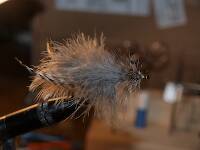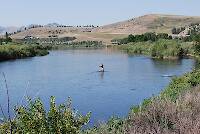
Hex Mayflies
Hexagenia limbata
The famous nocturnal Hex hatch of the Midwest (and a few other lucky locations) stirs to the surface mythically large brown trout that only touch streamers for the rest of the year.
Featured on the forum

I caught this tiny larva without a case, but it seems to key pretty clearly to to Glossosomatidae. From there, the lack of sclerites on the mesonotum points to either Glossosoma or Anagapetus. Although it's difficult to see in a 2D image from the microscope, it's pretty clear in the live 3D view that the pronotum is only excised about 1/3 of its length to accommodate the forecoxa, not 2/3, which points to Glossosoma at Couplet 5 of the Key to Genera of Glossosomatidae Larvae.

Troutnut is a project started in 2003 by salmonid ecologist Jason "Troutnut" Neuswanger to help anglers and
fly tyers unabashedly embrace the entomological side of the sport. Learn more about Troutnut or
support the project for an enhanced experience here.
PaulRoberts on Dec 1, 2010December 1st, 2010, 4:09 am EST
Below is my large cranefly tie. It was for trout in a NY Finger Lakes stream in which craneflies, among other things, were “food”.
One of my journal entries covering that stream:

Stomach pump results from a 17” brown trout with two cranefly types at the top (the translucent gold-tan and the olive). Also hellgrammites, and a scud (the orange due to digestion):

My tie:

Talk about simple to tie: An inch of poly yarn from a craft store tied on as a "tail", melted and rolled with fingers to a taper while still hot. Anterior end dubbed with slightly darker shade of same yarn. The hook is a Mustad 3906.
If I were to tie these now, I'd experiment tying them "wacky". That's a rigging method used for plastic worms and bass in which the hook is in the center, not distal. This allows the worm to be twitched. It's VERY effective. This fly begs for that.
Lemme know what you come up with. Always fun to hear about good patterns and scenarios.
One of my journal entries covering that stream:

Stomach pump results from a 17” brown trout with two cranefly types at the top (the translucent gold-tan and the olive). Also hellgrammites, and a scud (the orange due to digestion):

My tie:

Talk about simple to tie: An inch of poly yarn from a craft store tied on as a "tail", melted and rolled with fingers to a taper while still hot. Anterior end dubbed with slightly darker shade of same yarn. The hook is a Mustad 3906.
If I were to tie these now, I'd experiment tying them "wacky". That's a rigging method used for plastic worms and bass in which the hook is in the center, not distal. This allows the worm to be twitched. It's VERY effective. This fly begs for that.
Lemme know what you come up with. Always fun to hear about good patterns and scenarios.
JAD on Dec 1, 2010December 1st, 2010, 8:05 am EST
Good looking fly Paul, that fish that you pumped sure was feeding .
Best
John
Best
John
They fasten red (crimson red) wool around a hook, and fix onto the wool two feathers which grow under a cock’s wattles, and which in colour are like wax.
Radcliffe's Fishing from the Earliest Times,
PaulRoberts on Dec 1, 2010December 1st, 2010, 12:25 pm EST
Yes, those browns were often very fat. They used the mid reaches of a stream that cranked out large food items. This is true on many if not most brown trout waters. Such stretches are marginal in temperature in summer, and this particular one lost a lot of water too. But spring fishing could be pretty good, Water levels played a big role. Some years I could find those browns into June. But usually it (daytime fishing) was over by mid May.
Martinlf on Dec 1, 2010December 1st, 2010, 12:52 pm EST
Thanks for sharing this one, Paul. I'm going to give it a try. I may try your whacky rig too.
"He spread them a yard and a half. 'And every one that got away is this big.'"
--Fred Chappell
--Fred Chappell
PaulRoberts on Dec 1, 2010December 1st, 2010, 2:52 pm EST
Neat, Louis. Curious how it'll work. Wacky rigged worms are usually weighted, sometimes at each end. Something to experiment with.
I've been doing some stream sampling in local streams of late. I have to break some ice to get to the substrate but am finding stuff of course -despite what some angling writers say about winter trout streams. Some are "cranefly" larvae -watersnipe (Athericidae) and cranefly (Tipulid) larvae. The Tipulid was the same gold one I'd found in that NY stream (Hexatoma) and illustrated in the journal entry above. In the still water of my catch container they both swim in the same manner -flipping each end together, up and then down, ... in a writhing effort like a hyper-wacky rig. Not sure if they do this when dislodged in current though.
I've been doing some stream sampling in local streams of late. I have to break some ice to get to the substrate but am finding stuff of course -despite what some angling writers say about winter trout streams. Some are "cranefly" larvae -watersnipe (Athericidae) and cranefly (Tipulid) larvae. The Tipulid was the same gold one I'd found in that NY stream (Hexatoma) and illustrated in the journal entry above. In the still water of my catch container they both swim in the same manner -flipping each end together, up and then down, ... in a writhing effort like a hyper-wacky rig. Not sure if they do this when dislodged in current though.
FredH on Dec 2, 2010December 2nd, 2010, 1:05 am EST
Paul do they move like a mosquito larve? If so using a combination of rubber legs (from bass poppers)and dubbing could make for a deadly pattern rigged wacky.Hmm...... Great , now I have another project to add to my tying list.
PaulRoberts on Dec 2, 2010December 2nd, 2010, 3:25 am EST
Yes, like mosquito larvae but not side to side, and slower more cumbersome. Regardless, I think the "wacky" twitch is all that would be needed to add deadly 'life' to the fly. Underwater most materials are too well supported and will be stiff. That and proper weighting should go somewhere. Play in the sink and see what you can come up with.
Quick Reply
Related Discussions
Topic
Replies
Last Reply
Five days of warmwater flyfishing in southeastern Michigan - from Jonathon
In Fishing Reports by Jmd123
In Fishing Reports by Jmd123
0
Jul 22, 2009
by Jmd123
by Jmd123
1
Nov 18, 2007
by Martinlf
by Martinlf
Re: What's this sort-of caterpillar the rainbow trout was eating?
In the Identify This! Board by TSR
In the Identify This! Board by TSR
14
May 8, 2012
by Crepuscular
by Crepuscular







